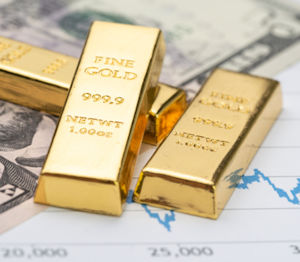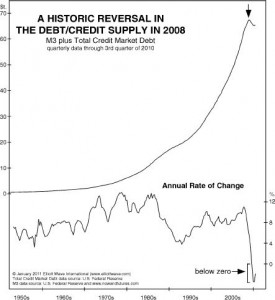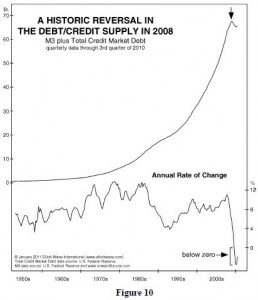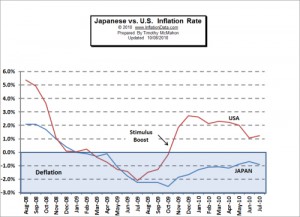Recently a subscriber asked me the question above, he gave quite correct arguments about how the stock market is "a zero sum game" in other words for every buyer there is a seller, so overall everything should stay in balance. But as I'm sure you know there are at least 3 ways to measure money supply M1, M2 and M3. Each one includes increasingly broad definitions. From just cash equivalents up to including all sorts of time deposits and Government debts. But what they don't include is stock valuations, however if the price of your stocks increases you feel richer and are more likely to spend money from your other accounts because you know if you need the money you can always sell your … [Read more...]
How Wealth Can Simply Evaporate
In the following article Bob Stokes of Elliottwave explains why in times of credit expansion money is created out of thin air and in times of credit contraction money can simply disappear... no matter how much the government prints out of thin air. This results in a negative "money multiplier" as more money disappears than is created. See my article on Velocity of Money and the Money Multiplier for more information.~Tim McMahon, Editor Evaporation of Wealth on a Vast Scale How $1-million can disappear By Bob Stokes The bursting of the "debt bubble" which started in 2008 is far from over. It's the financial story of our age and it's happening before our eyes. The full scope is hard to … [Read more...]
Soros Sells Gold- No Longer Fears Deflation???
When I think of using gold for asset protection I think of it for protection against inflation. But obviously, according to the WSJ, I am all wrong (or maybe not). According to a Wall Street Journal article, billionaire George Soros sold his $800 million stake in precious metals in the first quarter of 2011 saying that he "no longer fears deflation". What? With inflation climbing, I can see why he no longer fears deflation... but why would he buy gold to hedge against deflation, in the first place? … [Read more...]
Does Deflation Remain a Threat?
From physics we learn that every action has an equal and opposite reaction. From nature we see the pendulum swing to its farthest extreme and then return an equal distance in the opposite direction. Even children know the saying , "what goes up, must come down". But those laws of nature don't apply to debt and credit inflation do they? Can debt creation can go on forever? In this article the editors of Elliottwave International look at the largest credit inflation in history and where it is going now. Will it eventually result in a massive deflation? ~ Tim McMahon, editor A 90-Page "Deflation Survival Guide" Gives the Answer By Elliott Wave International "Every excess causes a … [Read more...]
Why Quantitative Easing Has NOT Brought Back Inflation
When the FED began quantitative easing to halt the deflationary crash of 2008, almost everyone was convinced that it would result in massive inflation. The lone voice proclaiming that it wouldn't stop the deflationary express train wreck was Robert Prechter. In the following article Prechter explains why inflation never materialized. It is an excerpt from Prechter's, Independent Investor eBook 2011. I hope you enjoy this short excerpt. See below for details on how to get the eBook in its entirety for free. ~ Tim McMahon, editor … [Read more...]
Understanding the Federal Reserve Bank
What's a greater threat to the U.S. economy -- inflation or deflation? To decide that... it helps to understand what role the U.S. Federal Reserve plays. Despite so much focus on the policies of the Fed, its operations remain somewhat of a mystery to most investors -- in no smaller measure, due to their complexity. Here's an excerpt of a 35-page report that explains the Fed, its goals and, very importantly, its limitations in layman's terms. … [Read more...]
Bernanke Is Making the Crisis Worse
By Bud Conrad, Chief Economist, Casey Research The Fed is a corrupt and powerful institution, and Chairman Bernanke is making the global crisis worse. His new speech given last week in Europe was terribly misguided and will upset markets as the Chinese and Germans won't ignore his challenges. Bernanke’s interpretations of the markets have been wrong since before he was appointed to head the Fed, and his actions are doing nothing but aggravating the situation. In this seminal speech, titled “Rebalancing the Global Recovery,” Bernanke not only defended QE II as the right policy, but also attacked the monetary policy of China, the biggest holder of U.S. debt, an action that must be … [Read more...]
The Case For Hyper-Deflation
by Carl BlackIn all of history, there has never been an episode of hyperinflation that involved a currency that exists primarily as digits stored electronically in accounting programs. Money is defined and decreed by government as being Federal Reserve Notes and Coins issued by the U.S. Mint, backed by the full faith and credit of the United States. The issue of what constitutes money within the United States is established by law and a matter of publicly accessible record and held as common knowledge. Credit is defined as the provision of resources (such as granting a loan) by one party to another party where that second party does not reimburse the first party immediately, thereby … [Read more...]
Inflation in the U.S. vs. Japan
The end of 2008 was a massive disinflationary period as the inflation rate fell from lofty heights until in January 2009 the inflation rate had fallen in both the U.S. and Japan to about zero. Deflation followed as the rate fell below the zero line through July. But then the two countries started diverging as the massive trillion dollar bailout began kicking in in the U.S. It kicked the U.S. inflation rate up to almost three percent before petering out. The inflation rate stayed negative (deflationary) in Japan however as prices continued to fall by 1% to 2% per year, which is probably where the U.S. would have been without the trillion dollar stimulus. Inflation in the U.S. currently … [Read more...]
Deflation or Inflation: Can Helicopter Ben Come to the Rescue?
Why the Fed Cannot Stop Deflation Countless people say that deflation is impossible because the Federal Reserve Bank can just print money to stave off deflation. If the Fed’s main jobs were simply establishing new checking accounts and grinding out banknotes, that’s what it might do. But in terms of volume, that has not been the Fed’s primary function, which for 89 years has been in fact to foster the expansion of credit. Printed fiat currency depends almost entirely upon the whims of the issuer, but credit is another matter entirely. What the Fed does is to set or influence certain very short-term interbank loan rates. It sets the discount rate, which is the Fed’s nominal near-term … [Read more...]





